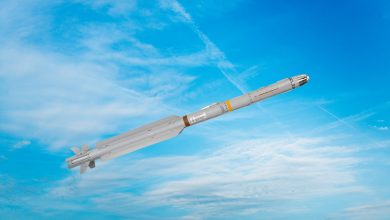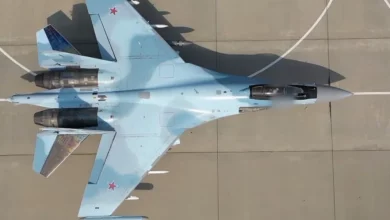Türkiye drives Mideast arms revenues as output woes hit global sales

Numerous Western arms companies encountered challenges in scaling up production in 2022 despite a significant surge in the demand for weapons and military equipment, a watchdog group said Monday, noting multiple output issues that had been further compounded by Russia’s invasion of Ukraine.
In its Top 100 of such firms, the Stockholm International Peace Research Institute (SIPRI) said the arms revenue of the world’s largest arms-producing and military services companies last year stood at $597 billion – a 3.5% drop from 2021.
U.S. and European arms companies could not significantly ramp up production capacity due to labor shortages, soaring costs and supply chain disruptions that were exacerbated by the war in Ukraine, SIPRI said.
In contrast, companies in Asia and Oceania, and the Middle East saw their arms revenues grow significantly in 2022, demonstrating their ability to respond to increased demand within a shorter time frame.
The Middle East, led by Türkiye, saw the largest percentage rise in revenue of any region.
Diego Lopes da Silva, a senior researcher at SIPRI, said in this context the slowdown in global revenue was “unexpected.”
“What the decrease really shows is that there is a time lag between a demand shock like the war in Ukraine and the ability of companies to scale up production and really meet that demand,” Lopes da Silva told Agence France-Presse (AFP).
“Many arms companies faced obstacles in adjusting to production for high-intensity warfare,” said Lucie Beraud-Sudreau, director of the independent institute’s Military Expenditure and Arms Production Program.
Production challenges hit US
SIPRI said the revenues of the 42 U.S. companies on the list – accounting for 51% of total arms sales – fell by 7.9% to $302 billion in 2022.
Of those, 32 recorded a fall in year-over-year arms revenue, most of them citing ongoing supply chain issues and labor shortages stemming from the COVID-19 pandemic.
U.S. arms suppliers are particularly vulnerable to supply chain disruptions as many of the weapon systems they produce are more complex.
“That means that the supply chain is also more complex, and it has more parts, which means it’s more vulnerable,” Lopes da Silva said.
Nan Tian, a senior researcher with SIPRI, said “We are beginning to see an influx of new orders linked to the war in Ukraine.”
He cited some major U.S. companies, including Lockheed Martin and Raytheon Technologies, and said that because of “existing order backlogs and difficulties in ramping up production capacity, the revenue from these orders will probably only be reflected in company accounts in two to three years’ time.”
Russian arms makers also saw revenues drop significantly in the report, falling by 12% to $20.8 billion.
The decline was in part due to sanctions imposed on Russia over Ukraine, but Lopes da Silva also noted that lower revenues could also be the result of delayed payments from the Russian state.
In addition, the transparency of arms makers in Russia has diminished and only two Russian companies were included in the top 100 “due to a lack of available data,” according to SIPRI.
The only Ukrainian company in the Top 100, UkrOboronProm, saw a 10% real-terms drop in its revenue to $1.3 billion.
Turkish Baykar’s revenues skyrocket
Companies in Asia and Oceania, and the Middle East saw their arms revenues grow significantly in 2022, the institute said in its assessment, saying it demonstrated “their ability to respond to increased demand within a shorter time frame.” SIPRI singled out Türkiye, Israel and South Korea.
The Middle East saw a revenue jump of 11% to reach $17.9 billion, as all seven region-based companies in the Top 100 recorded substantial growth.
Turkish companies in particular saw an increase, with Baykar – the prominent developer of unmanned combat drones – seeing a 94% jump in revenue.
Alongside Baykar (76), Aselsan (60), Turkish Aerospace Industries (82) and Roketsan (100) were the other prominent Turkish manufacturers that made it to the Top 100 world’s largest defense companies.
The four Turkish companies’ total arms revenues reached $5.5 billion – 22% more than in 2021 – the SIPRI report showed.
“Middle Eastern companies that specialize in less technologically sophisticated products were able to scale up production faster in response to surging demand,” said Lopes da Silva.
“A case in point is Türkiye’s Baykar, producer of the Bayraktar TB-2 drone. Baykar entered the Top 100 for the first time after its arms revenue rose by 94%, the fastest growth rate of any company in the ranking,” he added.
The combined revenue for arms suppliers in Asia and Oceania rose by 3.1%, reaching $134 billion in 2022.
It marked the second consecutive year where the Top 100 arms revenues for Asia and Oceania were higher than those for Europe.
The arms revenues of the 26 companies in the Top 100 based in Europe rose by 0.9% to reach $121 billion in 2022, the report showed.
China, which after the U.S. represented the second largest supplier by country, saw its eight arms companies in the ranking increase their combined revenues by 2.7%, reaching $108 billion.
The arms revenues of the seven companies from the United Kingdom listed in the Top 100 grew by 2.6% to reach $41.8 billion, or 7% of the total.
Looking forward, Lopes da Silva said there were no signs of demand slowing down.
“In the company reports, something very interesting that we found is that the order intake and the backlogs of the companies, they are increasing by a lot,” he said.
Added to that, many European countries have pledged increased military spending targets in the wake of Russia’s invasion of Ukraine, with some targets reaching all the way to 2030.
“We’re seeing that this demand will continue for the years to come. So we expect military spending to continue to increase and consequently arms revenues,” Lopes da Silva said.
Despite the year-over-year drop, the total Top 100 arms revenue was still 14% higher in 2022 than in 2015 – the first year for which SIPRI included Chinese companies in its ranking.
SIPRI also said that countries placed new orders late in the year and the time lag between orders and production meant that the surge in demand was not reflected in these companies’ 2022 revenues.
“However, new contracts were signed, notably for ammunition, which could be expected to translate into higher revenue in 2023 and beyond,” Beraud-Sudreau said.
Source: DailySabah





